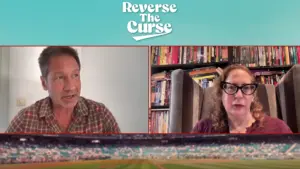“Body horror,” like “shoegaze,” would probably have been better off had it never become a genre.
Just as alt-rock became a whack-a-mole of cheap shoegaze and flat post-punk, each passing year yields a new crop of wannabe provocateurs who believe that some squishy sounds and fleshy close-ups will elevate their stylish, vapid works to cult status.
However! – unlike other recent, limp attempts (see: Infinity Pool (2023), Love Lies Bleeding (2024)), writer/director Coralie Fargeat’s new body horror epic The Substance commits to the bit with such enthusiasm, and goes so far beyond sense, taste and reason, that it escapes those bonds of imitation. The Substance is long and wandering – but truly insane.
The Substance stars Demi Moore as Elisabeth Sparkle, an aging starlet living out her final days of fame as a jazzercise host on network television. Upon her 50th birthday, Sparkle’s network boss Harvey (The Substance should not be noted for its subtlety), played by an electric Dennis Quaid, glibly informs Sparkle that her career is over and sends her packing. In the midst of her ensuing identity crisis, Sparkle gets propositioned by a mysterious entity that offers her the eponymous Substance. A chance for a younger self, and a second lease on life.

The Substance plays out like a fable, with its base premise never explained. That’s okay – it’s not the point. The point is that when Sparkle injects herself with green goop, a younger, hotter Sparkle named Sue (Margaret Qualley) rips out through her spinal column, and the two begin a shared existence, trading off every week while the inactive body lies catatonic on the bathroom floor. Sue gets Sparkle’s old job and becomes the next sensation, and a rift of resentment grows between the two.
As an allegory for the treatment of women in the industry, the increasing reliance on plastic surgery and the mutilation of the self-image, it is about as ham-fisted as it gets. Still, like everything else in The Substance, its bluntness doesn’t entirely negate its power. Demi Moore is pitch-perfect for the role (it’s difficult to imagine the film working without her), and as an exploration of those themes it is passionate and energetic, if shallow. Qualley too is perfectly cast, though it might be the shrimp-devouring, piss-spattering Quaid who steals the show.
Everything about The Substance is, frankly, obvious. The framing and colors are comically bold, Raffertie’s score is stock techno-minimalist Berghain scorchers, the plot makes no unexpected deviations. If you’re looking for a deep examination of Hollywood’s brutality towards women, you would be better served watching Mulholland Drive (2001), Sunset Boulevard (1950), or any of countless others. In fact, if I had walked out of the theater halfway through, I might have noted the film as forgettable.
But The Substance keeps going – and going – and I was glad that it did.

I won’t spoil things here, but the final stretch of The Substance is one of the most middle-fingers-up, splattering, nauseating, absolutely ridiculous catastrophes of taste and spectacle I have ever seen in a theater, and features some of the best prosthetics since The Thing (1982). Though The Substance won best screenplay at Cannes, I wouldn’t expect much notice at the Oscars – but its makeup should absolutely get the nod. It is stunning. And despite the obvious arc, the later turns validate Fargeat’s storytelling, and leave us with bookends that feel earned.
At a time when the industry has become obsessed with a dour literalism, it’s refreshing to enter The Substance’s subjective reality. Everything is abstracted. The era is unclear, Sparkle’s apartment makes no spatial sense, the science of the Substance and motivations of its creators are inexplicable. And all of that is for the better. Unlike its recent peers, The Substance has something to say, and says it with a humor and enthusiasm which would be diminished if expressed through a different lens.
Before there was a name for body horror, the films which became so categorized were trying new things, expressing new ideas. When alternative media falls back on recognized forms, the boundaries cease to expand and we are left with pastiche. The Substance, at least, understands its history; understands the importance of practical effects, the spirit of revolt, and the underlying humor inherent in the genre. On those virtues, and a trio of wonderful performances, it gets a high pass.













